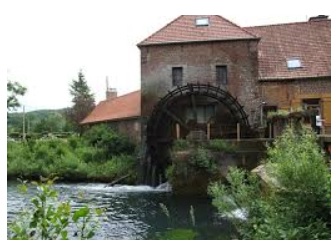 The mill’s construction drew on forests and quarries for raw materials, and on carpenters and masons for skills, stimulating demand and thus economic activity
The mill’s construction drew on forests and quarries for raw materials, and on carpenters and masons for skills, stimulating demand and thus economic activityOnce the mill was completed, the village could reduce costs of flour and products such as bread and pastries which could be sold beyond the town limits. Cereals from neighbouring towns were also milled, making the enterprise a success, and the town prosperous
 Financing was done by paying contractors and suppliers with IOUs promising a measure of milled flour. These vouchers were found to have value beyond just claiming flour from the mill, since the baker accepted them as payment, and soon other merchants and tradespeople as well, forming part of the currency supply and expanding economic activity
Financing was done by paying contractors and suppliers with IOUs promising a measure of milled flour. These vouchers were found to have value beyond just claiming flour from the mill, since the baker accepted them as payment, and soon other merchants and tradespeople as well, forming part of the currency supply and expanding economic activity
- - -
This new currency was spent into the community for supplies and skills, causing a boom by expanding the economy. Everyone was happy and grateful to the banker
At the end of each month, the amount owed in interest was taken out of the com
 munity by the miller, and other entrepreneurs with loans, to pay the banker. This reduced the currency supply, making it more and more difficult to do business with less and less currency
munity by the miller, and other entrepreneurs with loans, to pay the banker. This reduced the currency supply, making it more and more difficult to do business with less and less currencySome businesses were obliged to borrow more to keep the doors open, while others cut staff and purchases causing unemployment. Inevitably, business started going bankrupt, leaving the town destitute

- - -
A common misconception is that banks lend the currency deposited by savers. Lenders pay interest charges on their loans, and savers receive interest on their savings
 When economic activity declines, demand for currency declines, reducing interest rates, thus making it cheaper for entrepreneurs to fund expansion or new businesses, while consumers have less incentive to save, and thus spend more. When the economy "overheats", the reverse takes place "cooling" the economy through higher rates
When economic activity declines, demand for currency declines, reducing interest rates, thus making it cheaper for entrepreneurs to fund expansion or new businesses, while consumers have less incentive to save, and thus spend more. When the economy "overheats", the reverse takes place "cooling" the economy through higher ratesIn this scenario, banks are brokers of currency, passing the currency of the saver through to the borrower. They cannot create currency, nor lend out more than they have in savings (100% reserve requirement)
Currency for expanding economies comes from central banks, such as the publically owned Banque du Canada that managed currency supply and interest rates prior to 1973. New currency and interest was spent by the government. An alternative proposed by social credit, for example, suggested social dividends paid to each person directly
Both of these approaches to spending new currency and interest strengthened the demand side of the economy, causing expansion either by new spending, or more capital
- - -
In reality, no government has control of its currency or interest rate (except perhaps(?) North Korea and Iran) since most central banks are private banksEven the few publically owned banks such as the Banque du Canada have been relegated to façades since 1973 (in violation of the law), which does not even have a lending window to banks since there is no minimum reserve requirement in Canada, UK, and a few others. Even banks in countries with reserve requirements can borrow the fractional reserve from the (private) central bank meaning there is no limit in reality
What this means is that private banks create national currencies
Worse, this new currency is not spent by government budgets or social dividends, but issued as debt at interest
Let us consider interest and debt
Interest
When a loan is created (out of nothing), the borrower is obliged to repay not only the principal, but the interest. Note that:- All loans thus cannot be paid off since there would then be no currency
- The amounts for interest payments are not created
Bankruptcies are thus an inevitable part of the system - it is designed that way!
Debt
Debt is a claim on assets and labour. Declaring bankruptcies does not "clean the slate", but dispossesses the debtorPossession of everything is the objective, whether through:
- Communism, where no-one owns anything because someone owns everything
- Dispossession through bankruptcies, accelerated with credit contraction in "business cycles"
- Buying up ownership of publically traded corporations with created money, bailouts, and QE
- Bankrupting nations and taking over their pensions, infrastructure, land, etc., through austerity measures
- Destroying nations' coherence and identity, and thus eroding their ability to maintain their culture and defend themselves
- War, which is simply theft at a grand scale
- etc.
- - -
Solutions range from prohibition of interest (Islam, Catholic...), precious metals based currencies (Bretton Woods...), crypto currencies (Bitcoin, Ethereum, Ripple...), community networks (LETS...), etc.
In the following articles we will discuss these alternatives and propose a solution with a reasonable prospect of successful implementation
Financing of the watermill
No comments:
Post a Comment